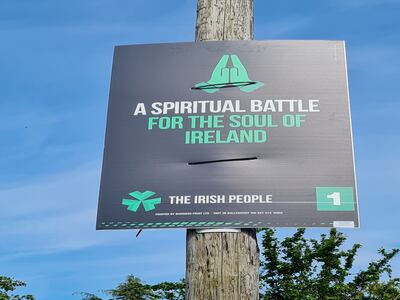They stare at you from lamp-posts and billboard hoardings, their smiling faces pleading for your Number One. Well, most are smiling – a minority of candidates in the local and European elections go for either a neutral look or something altogether more severe.
Such designs are not by accident. Politicians are selling a message, and the imagery, slogans and choice of colours on their posters are part of that.
The prominence of the party logo is a factor: Sinn Féin candidates go relatively big, compared, for example, with Labour whose “starry plough” seems like a footnote on Aodhán Ó Ríordáin’s posters. Visuals and props and sometimes added: Ciaran Mullooly is pictured next to some cows on a mobile campaign hoarding, while Bríd Smith puts a Palestinian flag next to the photo.
Are there more subtle messages being communicated? The Irish Times sought some expert advice.
Belfast-born psychologist Prof Geoff Beattie says he found in his research that “smiling faces were perceived as more attractive, more sociable and more intelligent than non-smiling faces”.
The former on-screen analyst for Channel 4′s Big Brother series has just published a new book on Lies, Lying and Liars – serendipitous, some might say, with elections taking place in Ireland and the UK this summer. People will unconsciously judge someone who is smiling “to be more capable”, he says. “Just as long as we don’t perceive him as faking it. We don’t like fakes. It’s a difficult balance.”
Prof Vlad Glăveanu, of Dublin City University’s school of psychology, says candidates are walking a “tightrope between appearing competent and being approachable”.
“This can lead to some awkward poses and smiles and a tension between engaging viewers directly – through what seems like direct eye contact, for instance – and indirectly: for example, looking elsewhere so they are looked at rather than looking back, which can be assertive without the risk of appearing aggressive.”
Glăveanu, who has carried out research on how the mind processes images, says “most elements in an ad aim to communicate something. Colours identify a party and connect to local or national identities”. As for the use of slogans, “we process words and images differently and oftentimes longer messages require more cognitive effort to unpack but can leave a greater mark. This is why three-word slogans can be very popular as they offer the benefit of higher engagement while being easy to remember and pass on ... ‘Take Back Control’ [the Brexit catchcry] comes to mind.”
What about some examples from the campaign trail?
1: Holly Cairns, Social Democrats
Glăveanu: “The colours and slogan want to suggest dynamism, confidence, and a longer term perspective – [party leader Holly Cairns] is looking in the distance. The use of the word ‘change’ is emphasised, in the background, by the use of three colour bands and a colour contrast.”
Beattie: “Holly is looking away from the camera trying to convey that her smile is more natural and spontaneous, and therefore genuine. She is signifying change by looking away, a break from the traditional fake smile of the politician straight to camera. The pursuit of authenticity and naturalness.”
2. Mick Wallace, Independent
Glăveanu: “Breaks with convention in its visual arrangement and this emphasises the idea of ‘bolder’ from the slogan. The focus on the eyes is meant to suggest closeness and sincerity but the gaze is not direct – the eyes are looked at rather than looking back (a more extreme case is the Mona Lisa) – which is engaging but not threatening.”
Beattie: “‘Older and bolder’ reads the message. The wrinkles around the eyes reinforce this message. The marks of experience. ‘We won’t be fooled again,’ is the implicit message. The overall image is a bit like ‘Big Brother is watching you’, but with kinder, sadder eyes. He will act on what he sees. Trust me, look into my eyes.”
3: Barry Andrews, Fianna Fáil
Glăveanu: “A more traditional political ad with a pose, outfit and smile that are common for this kind of communication. The background, however, is deliberately lively and representative of Dublin, adding dynamism to the image and suggesting national pride.”
Beattie: “The smile straight to camera. An attempt to smile with the eyes to make it look more genuine, and an attempt to keep it symmetrical on both sides of the face. An urban modern setting. The message is here is a relaxed, modern man comfortable with the modern world and in control, happy with change.”
4. Luke Ming Flanagan, Independent (Early career poster which he re-promoted on his social media channels for the current campaign)
Glăveanu: “The use of black and white normally adds historicity but in this case there is a contrast established with the youthfulness of the candidate as depicted in the ad, yet another tension that is supposed to catch the viewer’s attention and make them look twice.”
Beattie: “A different sort of look and body language for a politician. Pointing at the passerby in almost a confrontational manner. The implicit measure is that I know what goes on, I’m not naive like some politicians. I’m up for the rough stuff, if you just elect me.”
5. Grace O’Sullivan, Green Party
Glăveanu: “This ad, expectedly for the Green Party, suggests connections with nature even if the natural background is blurred. The different shades of green, light blue and yellow (including the green earrings) as well as the breeze that gently moves the candidate’s hair are all meant to indicate warmth, confidence, and movement.”
Beattie: “No airbrushing here. I’m not going to fake a politician’s smile for the camera. You deserve more than this kind of act. But I’m not looking down on you either. The environment and climate change are the biggest problems we face but we can work together on this. No time for make-up, fakery, or airbrushing. Let’s get to work!”
6. The Irish People party

Glăveanu: “This one is atypical as it doesn’t show a candidate but a logo and a slogan. The two hands come together in what resembles a basic prayer emoji and is meant to emphasise the idea of spirituality ... Emotionally charged words like ‘battle’ are being used but, again, the ad lacks dynamism and tries to be solemn rather than vivid while, at the same time, creating a divisive dichotomy between ‘Irish people’ and the unnamed others (the non-Irish and arguably non-Christian) against whom the supposed (spiritual) battle is to be fought.”
Beattie: “A different sort of representation. Symbolic ... The hands in prayer. Instantly recognised, instantly decoded. Praying for success in the battle to come.”
- Sign up for push alerts and have the best news, analysis and comment delivered directly to your phone
- Join The Irish Times on WhatsApp and stay up to date
- Listen to our Inside Politics podcast for the best political chat and analysis












